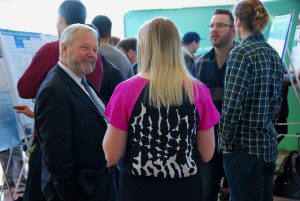
The best way to learn how to do something, is to do it! We are six brand-new Elves who have spent the morning with Head Mental Elf André Tomlin, learning about using blogs to get the evidence out to you. We’re excited to bring you this summary, which showcases a new feasibility study that is the first of its kind. The authors, from Imperial College, investigated the safety and efficacy of using Psilocybin for people living with unipolar treatment resistant depression.
Psilocybin naturally occurs in the Psilocybe genus of mushrooms, or ‘magic mushrooms’, and is well known for its psychedelic properties. There is some evidence that psychedelic experiences may have antidepressant potential in human beings, but no previous clinical trials have tested psilocybin’s effect on depressive symptoms.
This study looked at how the use psilocybin alongside psychological support affected 12 people who had lived with depression for much of their adult life and had had little sustained response to previous treatments. The researchers hope the results of this small scale study will encourage further research in this area.

The feasibility study sought to pave the way for future research.
Methods
This small-scale, preliminary study examined the safety, feasibility and efficacy of psilocybin for people with major, treatment-resistant depression.
The study was done in 2015 with participants with moderate to severe, unipolar depression (17+ on the 21-item Hamilton Depression Rating Scale) which was treatment-resistant (no improvement after at least two courses of different antidepressants lasting at least 6 weeks within the most recent depressive episode).
Participants were recruited via GPs in North West London and via self-referral following study publicity, including presentations and media coverage.
The study participants were given two oral doses of psilocybin, 7 days apart. The first was an initial safety dose (10mg) and the second was a treatment dose (25mg). Both doses were given in a supportive environment at a research facility. During the dosing, participants listened to music while they sat or lay down on a ward bed. Two psychiatrists stayed with them for support, and the participants also received psychological support before and after the intervention. There was no control group in this study.
The study measured several outcomes:
- Safety: Clinical monitoring for adverse events
- Feasibility: Patient-reported subjective intensity of the drug’s effects
- Preliminary efficacy: Mean change in severity of self-reported depressive symptoms using the Quick Inventory of Depressive Symptoms (QIDS) from baseline to 1 week after the high dose.
- The QIDS was also measured at 2, 3 and 5 weeks, and 3 months.
- Depression and anxiety were also measured with the HAM-D, MADRS, GAF, BDI, STAI-T, and SHAPS scales.
The study was reviewed and approved by the MHRA and a National Research Ethics Committee (London – West London), and registered with the ISRCTN (ISRCTN14426797).
Results
The authors recruited 12 people. Ten of them self-referred to the study after hearing about it through the authors’ public outreach. Nine of the participants had severe or very severe depression; the other three had moderate depression.
Side effects
The participants all tolerated the intervention well. No-one needed tranquilising medication and only mild adverse effects were reported during and after the intervention:
During the intervention:
- Anxiety (mostly mild) (n=12)
- Transient confusion or thought disorder (n=9)
- Mild and transient nausea (n=4)
- Transient headache (n=4)
- Mild and transient paranoia (n=1)
After the intervention
- Subacute headaches lasting 1-2 days the day after the intervention (n=4).
Depression and anxiety
Participant and clinician-rated depression scores were both positive: all of the participants had reduced depression scores 1 week after the intervention, and most still had reduced scores after 3 months. For example, the QIDS score was mean=19.2 (SD=2.0) before the invention, dropped to mean=7.4 (SD=4.9) after 1 week, and rose to mean=10.0 (SD 6.0) after 3 months. Anxiety scores were also improved 1 week and 3 months after the intervention.
Although these trends were generally positive, the results for each individual were varied. After 3 months, five of the participants were in complete remission, according to the QIDS score, but one participant’s depression was worse and they were referred to their GP.

Psilocybin is a promising treatment for depression, but not yet something that can be recommended based on this evidence.
Strengths, limitations and implications for practice
We found the planning, design, and conduct of the study good and congratulate the authors on successfully completing this research and so openly discussing the limitations and next steps.
As the authors point out, this is a feasibility study, so should not be used to guide treatment options for patients. The focus of the study was the efficacy and safety of the proposed treatment, which the results support.
The paper is a little tricky for non-specialists, as it doesn’t give much detail about the depression and anxiety scales used. References to the main validity studies for each of the outcome measures would have been useful. Figure 4 would also be easier to interpret if it included the depression stability for an equivalent time (3 months) before the intervention.
As always, patients and carers should be consulted when planning future trials.

As always, patients and carers should be consulted when planning future trials.
Conclusions
We thoroughly enjoyed critically appraising this study and blogging about it as a group. The researchers have planned this feasibility study of a tricky intervention well and reported it in such a way that was easy to read and understand for non-specialists.
The real value of this research is what happens next. We would love to see adequately powered randomised trials designed with the input of patients and carers. As a result of our discussion, we’re really curious in hearing what the authors plan to do next, and how they dealt with the complexities of this study. We generated some questions below and hope that the authors and others will respond.
Questions
- Did you get any challenges from the ethics committee when planning this study?
- How did you feel about the press coverage of the study?
- Moving from a feasibility study to randomised comparisons of psilocybin with existing alternatives or different dose of psilocybin, what information will you use to estimate the sample sizes needed to obtain adequate measures of treatment differences on beneficial and potentially harmful effects?
- Are you planning a dosing trial?
- What comparative group(s) are you planning in the next step?
- What do you think about multiple groups running similar trials or would you consider a multicentre trial?
- Will longer term surveillance of the volunteers be part of future designs particularly for randomised studies, not only to ensure that longer-term beneficial and adverse effects are evaluated but also for patient safety?
- The WHO ICTRP has a number of registered trials with different populations using psilocybin. Are arrangements being made to evaluate side effects in the trials using meta-analyses, including longer time frame adverse effects?

Opening the door to new possibilities in mental health research.
Bloggers
Our thanks to Iain Chalmers, Lizzie Coates, Jennifer de Beyer, Darryl McGill, Claire Murray and Rebecca Neale who worked together to publish this blog as part of our Making #EvidenceLive workshop on 21st June 2016.
Links
Primary paper
Carhart-Harris, Robin L et al. (2016) Psilocybin with psychological support for treatment-resistant depression: an open-label feasibility study. The Lancet Psychiatry
Other references
Cowen, P. (2016) Altered states: psilocybin for treatment-resistant depression. The Lancet Psychiatry
ISRCTN entry – http://www.isrctn.com/ISRCTN14426797
Photo credits
drp via Foter.com / CC BY-NC-ND

Magic mushrooms promising for treatment resistant depression https://t.co/vuu1xZ1Atb #MentalHealth https://t.co/VEyKPEEUxM
RT @BMJ_CE: First of 3 blogs written in #SoMe workshop at #EvidenceLive https://t.co/mnegk1ZwGA https://t.co/pFvc2w6mks
We’ve blogged your recent #psilocybin study in @TheLancetPsych
https://t.co/oKsVfoNcsY
#EvidenceLive
Great work! https://t.co/myBTleOfSe
@Mental_Elf but shouldn’t it point out as well that we have no clue if any effect is really due to the treatment? (No control group)
@Mental_Elf @TheLancetPsych Mental ‘ealth.. Come on
Magic mushrooms promising for treatment resistant depression https://t.co/yR7caPDRdf via @sharethis
How can we do power calculations for an #RCT when all we have is an uncontrolled case series? https://t.co/oKsVfoNcsY #EvidenceLive
#Psilocybin for treatment resistant depression https://t.co/oKsVfoNcsY
Would love to hear your response to these Qs https://t.co/Mf4lHeJIAz
@Mental_Elf @RobinCarhartHar @mark_bolstridge @docbloomfield @ProfDavidNutt @iainchalmersTTi @EQUATORNetwork https://t.co/BR14E2FnLW
@Mental_Elf Good Questions but I don’t think we have any cast-iron answers as yet but preparations are well underway
Magic mushrooms for treatment resistant depression
The thoughts of @iainchalmersTTi et al
https://t.co/oKsVfovB4o https://t.co/QvwVCKSRNM
@Mental_Elf what do you think? @iainchalmersTTi
Is it really worth spending this effort to report on a tiny uncontrolled trial, from which no conclusions can be drawn?
Why not wait until there is some real evidence?
Yes it is worth it. This is basically a brilliantly accessible “live” published “protocol” for a great future trial. I agree the press release you mention below is irresponsible and may give false hope when the papers get hold of it. This publication is not hype. It’s saying that it’s worth doing a trial on this intervention, and let’s make sure it’s designed properly. What’s so wrong about saying that? It’s a positive message well worth blogging about.
Well put, Caroline? Thanks.
Magic mushrooms promising for treatment resistant depression https://t.co/GYA4uiBCRy via @sharethis
Magic mushrooms promising for treatment resistant #depression https://t.co/5VmarZPHBa @Mental_Elf on a small feasability study. #Psilocybin
Group blogging! What a fantastic initiative and congratulations to the National Elf Service for another first! A very interesting and useful analysis of this new research. More appealing to me than group hugging, but maybe that’s just my British reserve. Looking forward to doing a group blog next week at EQUATOR Publication School #eqpubschool
Not only too preliminary to be worth reporting, but a thoroughly irresponsible press release too. http://www3.imperial.ac.uk/newsandeventspggrp/imperialcollege/newssummary/news_17-5-2016-10-42-14
It does not help patients to give them false hope. And hype is very bad for the reputation of all science.
Magic mushrooms promising for treatment resistant depression https://t.co/6MUKNtaR5K via @sharethis
Magic mushrooms promising for treatment resistant depression https://t.co/TZBraBEh9d